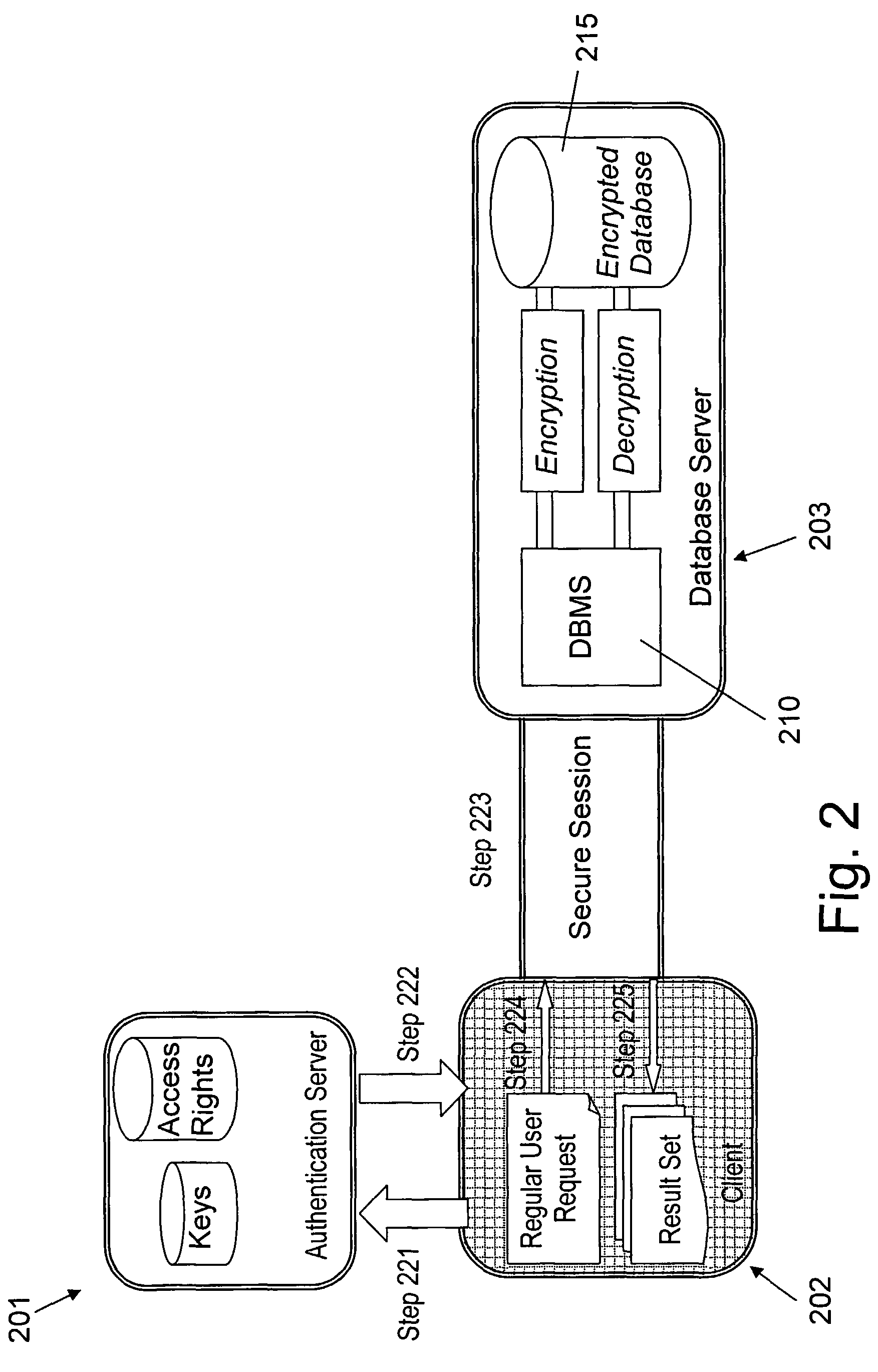The first three
layers alone are not sufficient to guarantee the security of the database since the database data is kept in a readable form.
However, once the data arrives securely at the certified
server support in storing and
processing the data in a secure way is inadequate.
Security and privacy aspects of private data stored on a data storage
server have recently become an interesting and challenging field of research.
Anyone having access to the encrypted data cannot learn anything about the sensitive data without the encryption key.
However, U.S. Pat. No. 4,375,579 has a number of significant disadvantages:a. It relays on a specific encryption function and not on any symmetric or asymmetric encryption function.b. Each encrypted
record is a single function of all of its field values and each field is encrypted with a separate encryption key.
One
disadvantage of all the above methods is that the basic element in the database is a row and not a
cell, thus the structure of the database is modified.
In addition, all of those methods require re-encrypting the entire row when a
cell value is modified.
The
disadvantage of the field oriented encryption method is that it is not resistant to substitution attacks trying to substitute two encrypted cells.
The
disadvantage of the
record oriented method is similar to the one of the
record oriented encryption methods discussed above.
However, the proposed method does not protect from attacks that substitute two encrypted values in the database and requires query translation since the pseudo-random bits for a value searched need to be computed by the
client.
One of the disadvantages of that method is that the DBA can perform no administrative tasks on the database, since the entire content of the database is encrypted.
While data owners may not entirely trust providers' discretion, preventing a provider from inspecting data stored on their own machines is difficult.
However,
access control is useless if the attacker simply gains access to the raw database data, thus bypassing the traditional mechanisms.
Furthermore, it protects
data integrity as unauthorized modifications can easily be detected.
Furthermore, if several users with different access rights use the same index, each one of them needs access to the entire index, possibly to indexed elements, which are beyond his access rights.
Using this approach requires more computation by the
client since the result of the queries is not accurate.
However, the above methods described in “A Framework for Efficient
Storage Security in RDBMS” by Iyer, B., Mehrotra, S., Mykletun, E., Tsudic, G., and Wu, Y., and “
Chip-secured
data access: Confidential Data on Untrusted Servers” by Bouganim, L., and Pucheral, P. implemented at the level of the
operating system are not satisfactory since in most cases it is not possible to modify the
operating system implementation.
Furthermore, in these methods, it is not possible to encrypt different portions of the database using different keys.
However, the above method does not support range queries and query translation has to be performed since the
client has to compute the “trapdoor” from each keyword searched.
The major drawback of the last two methods is that there is no support in indexes structured as trees since the
server can only perform exact matches to the user's query and thus lacks the ability to evaluate the relation between two tree nodes in the index.
However, revealing the order of the encrypted values is not acceptable for any application.
However, since references between the B+-Tree nodes are encrypted together with the index values, the index structure is concealed, and therefore the DBA finds the index unmanageable.
Active attacks are more problematic, in the sense that they may mislead the user.
For example, modifying index references to the database rows may result in queries returning erroneous set of rows, possibly benefiting the
adversary.
For example, if a hash index is used and the values therein do not distribute equally, performance might be undermined, and the DBA might wish to replace the
hash function.
However, in most cases, using encrypted indexes causes performance degradation due to the overhead of decryption.
Encrypting the whole database using the same key, even if
access control mechanisms are used, is not enough.
However, a fundamental problem arises when an index is used for that column.
The same problem arises when the index is updated.
Encrypting each column with a different key, results in a large number of keys for each legitimate user.
The dynamic nature of encrypted databases adds complexity and special requirements to the
key management process.
However, since the keys are never kept in the
database server after a session terminates, an attacker can not learn anything about the database values as he has no access to the encryption keys.
First, two equal
plaintext values are encrypted to equal
ciphertext values. Therefore, it is possible, for example, to collect statistical information as to how many different values a specified column currently has. The same holds for the ability to execute a join operation between two tables and collect information from the results.
Second, it is possible to switch unnoticed between two
ciphertext values. Different
ciphertext values for equal
plaintext values can be achieved using a polyalphabetic
cipher, for example Vernam
cipher. However, in this solution decryption of a record depends on other records and thus requirement of decryption
granularity described above is violated.
Better performance and preserving the structure of the database can not be achieved using pages or whole table / index encryption
granularity.
 Login to View More
Login to View More  Login to View More
Login to View More 


